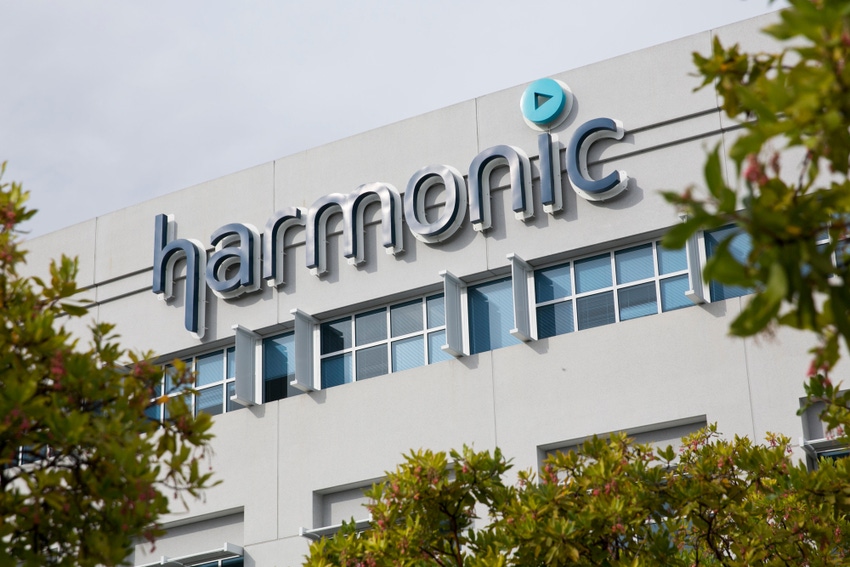Broadband sales to accelerate in second half of 2024, Harmonic says
While forecasting a soft first half of 2024, Harmonic expects broadband sales to speed up in the second half of the year, aided by DOCSIS 4.0 rollouts. Harmonic is still evaluating a potential sale of its video tech unit.

Coming off a record fourth quarter of 2023, Harmonic expects sales in the first half of this year to be relatively soft and then accelerate in the second half of the year as operators start to ramp up network upgrades, including moves to DOCSIS 4.0 technologies.
Harmonic's expectations on a strong second half of 2024 likely reflects slower near-term rollouts from Harmonic's top two customers – Comcast and Charter Communications, Raymond James analyst Simon Leopold reckoned in a research note.
"We suspect Comcast will pivot aggressively to DOCSIS 4.0, but the timing of obtaining FDX [Full Duplex] amplifiers from CommScope may restrain the roll-out," he wrote.
Years of runway
However, Harmonic expects a long runway ahead as cable operators and telcos beef up their legacy networks and build fiber-to-the-premises (FTTP) networks for edge-outs and deployments in underserved and unserved rural areas.
That pipeline extends out "certainly another four to five years," Harmonic CEO Patrick Harshman predicted Monday on the company's Q4 2023 earnings call. "I expect the pace going forward to be slightly faster than the pace we've seen today, but not dramatically so. I think that sets us up for four, five, six-plus strong years of investment and opportunity in this area."
For now, the bulk of Harmonic's opportunity is with Comcast and Charter Communications. Comcast, which is working with Harmonic on network upgrades, including its initial DOCSIS 4.0 deployments, represented 41% of Harmonic sales in Q4 2023. Charter, which is now starting to push ahead with its own network upgrade plan, represented 15% of Harmonic sales during the period.
Operators flirting with DOCSIS 4.0-ready nodes
While it's clear that some operators intend to push the limits of their DOCSIS 3.1 networks before upgrading to DOCSIS 4.0, Harshman said Harmonic is seeing increased operator interest in deploying DOCSIS 4.0-ready nodes that can run in DOCSIS 3.1 mode.
"We're seeing some rethinking by customers," he said, noting that one "large customer" has pivoted to using Harmonic's DOCSIS 4.0-ready nodes. "There is not, certainly domestically, a significant operator who is not contemplating DOCSIS 4.0 for at least part of their strategy. It's part of the dialog with everyone."
Virtual CMTS now running 26.3 million cable modems
Harmonic also made some progress with cOS, formerly known as "CableOS," a virtual cable modem termination system (vCMTS) that also can be applied to FTTP networks. Harmonic added five cOS deployments in Q4, for a total of 108.
Harshman said a new, but unidentified top ten North American cable operator selected cOS during the quarter and initial shipments are underway. Examples of other operators in the region that have already selected cOS include Comcast, Charter, Rogers Communications and Mediacom Communications.
Harmonic's cloud-based platform now serves about 26.3 million cable modems, or about 15% of the number of cable modems deployed globally, after adding 2.8 million modems to that total in the quarter.
That result should extend Harmonic's lead in the vCMTS market, where it competes primarily with Casa Systems and CommScope.
FTTP use cases for cOS are on the rise, as the company notched "several" new fiber wins for the platform among cable operators and non-cable operators, Harshman said. To brace for that, Harmonic has been ramping up a fiber specialist team.
"We remain very much on track to make fiber a strong strategic and financial contributor to our business," Harshman said.
Strategic review of video biz continues
Harmonic's strategic review of its video business is ongoing. Announced last fall, Harmonic kicked off that process after some interested buyers reached out.
That review is a "top priority" for Harmonic, but "no specific timetable has been established for the completion of the review," CFO Walter Jankovic said. "We are not providing any further detail on this process unless and until a definitive agreement has been reached and our board approves the transaction or it decides to conclude the review."
Raymond James analyst Simon Leopold estimated last fall that Harmonic's video business could be worth $350 million to $500 million.
In Q4, Harmonic's video segment pulled in $51.9 million, down 24.1% year-over-year. However, the software-as-a-service (SaaS) part of that business saw revenues climb 26%, to $13.2 million, driven by the streaming of live sporting events.
Harshman said Harmonic's video SaaS platform powered the "largest live streaming event ever in the US" – an obvious reference to Peacock's exclusive stream (outside of the local TV markets) of the January 13 NFL Wild Card game between the Miami Dolphins and Kansas City Chiefs that drew an average audience of about 23 million viewers across Peacock, NBC stations in Miami and Kansas City and on mobile via NFL+.
Financial snapshot
Harmonic posted record Q4 sales of $167.1 million, well within its guided range. Q4 broadband revenues of $115.2 million, also a record, rose 20% from the year-ago period – ahead of the $109.5 million expected by Raymond James.
Looking ahead, Harmonic expects Q1 2024 broadband revenues of $70 million to $80 million, and video revenues in the range of $40 million to $50 million. For full-year 2024, Harmonic expects broadband revenues of $460 million to $500 million, and video revenues of $195 million to $210 million.
Harmonic recently closed a five-year $160 million credit facility that includes a $120 million revolving credit line and a $40 million delayed draw term loan. That will help Harmonic pay 2024 convertible notes outstanding while providing "ample liquidity and flexibility" for the company to execute its multi-year growth plan, Jankovic said.
About the Author(s)
You May Also Like












